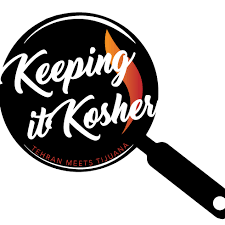
Why do we need Kosher Guidelines?
The outlines of Kashrut are found in the Torah, and are expanded in the Talmud. The word “Kosher” literally means “fit” or “proper”.
The laws of Kashrut, of keeping Kosher, are associated with holiness in the Torah. Together with the blessings we say when we eat, they raise the act of eating from one of merely satisfying hunger to a spiritual realm.
Kashrut is also a statement of Jewish identity. It links us to our Jewish heritage, to the generations who preceded us and to Jews the world over. The actual foods we may choose to eat may be different in origin but they will have Kashrut in common.
We are a Kehilla Kedosha, a sacred community. As such, we must be welcoming and inclusive to all our members and guests who observe the dietary laws. We know that people may have varying interpretations of aspects of Kashrut but as a synagogue, we must have clear and consistent guidelines for all.
We trust that all our members and friends, whatever their personal practices may be, will be willing to observe these guidelines so that all may be comfortable sharing in the joy that we find in communal meals.
In addition, all synagogue or synagogue adjacent functions, must also abide by guidelines set forth to ensure everyone’s comfort level with the food and with Jewish observance.
Guidelines for ITEMS FROM HOME can also be found here
Main Kitchen Rules
Standards for Raw Ingredients and Processed Foods
Special Notes
Items from Home
Items may be brought from home or made at home ONLY when specifically allowed by the Rabbi. Whether you are buying or making a dish, it is commendable to use hekshered products where possible. The innovation is that we are allowing non-hekshered vegetarian and dairy products, and allowing food made in private homes – regardless of their Kashrut level – to come to the buffet table.
When buying ingredients for such an event when food is allowed to be brought from home, check the packaging for a heksher. Please note that there are many kinds of hekshers, but K is NOT a heksher. It is the manufacturer’s opinion that the food is kosher. If there is no heksher, read the ingredients. All ingredients should be vegetarian or pareve/vegan. If there are unfamiliar words, you may wish to take a picture of the label and share it with the Rabbi for verification. It is preferrable to buy hekshered products when possible.
When preparing food at home: Begin with a freshly cleaned sink, workspace, and utensils. As you prepare the food, be careful to use freshly clean utensils.
If your recipe includes eggs, crack one at a time in a glass and check for blood spots. If it has blood spots you must discard it. Use only eggs that are blood free. Pour that egg into the bowl, then crack the next one in the glass, inspect, and (if no blood spots) add it to the bowl. Repeat until you have all your eggs in the batter.
If you are putting two items in the oven, one for FHC, and a different one you made for yourself, make sure that one is covered so there is no splatter from one to the other.
Delivery: You may bring your food to the synagogue prior to Shabbat (Yay for Fobs! You can get into the building.) The building is open Wednesday evenings. Friday you can get in from 9 to 4:00 (Please check for candle lighting time on Fridays which is listed in our weekly News You Can Use email.)
You may bring your dish with you on Shabbat if you choose.
PLEASE LABEL YOUR OFFERING. PUT YOUR NAME, THE NAME OF THE DISH, and ‘HEKSHERED’ OR ‘NOT HEKSHERED’. This is for transparency purposes. All foods will be served on disposables. At the end of the meal, you are invited to take the remainder of your dish back home. (Consider a swap or gifting, if you like.)
*Revised April 2023